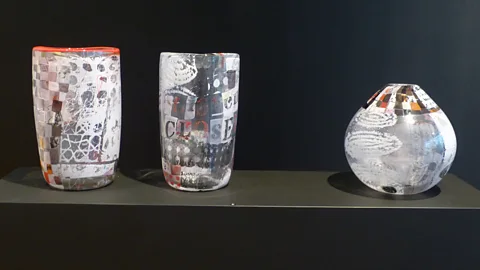 Getty Images
Getty ImagesNearly a decade before Swedish climate activist Greta Thunberg was even born, Växjö set itself on a path to a new vision of green urban living.
The 1,000-year-old Swedish city of Växjö sits 450km south-west of Stockholm in the central region of Småland amid a lush tapestry of sylvan landscapes dotted by hundreds of lakes. This is a land known as the Glasriket (“Glass Kingdom”) that’s home to a string of globally renowned glassworks such as Kosta Boda and Orrefors who have created crystalline gorgeousness from fiery furnaces since the 1740s.
But that glassmaking heritage is now matched by changemaking: this compact city of fewer than 100,000 inhabitants has become a global beacon in the battle against climate change. Nearly a decade before Swedish climate activist Greta Thunberg was even born, Växjö set itself on a path to a new vision of urban living that’s now been emulated worldwide.
“It was a seminar in 1996 led by the mayor, which asked the question: ‘What would it be like to live in a fossil free city?’,” explains Henrik Johansson, environmental strategist for Växjö Municipality. By the end of that meeting, a unanimous vote saw Växjö become the first city in the world to commit to become fossil fuel free. This has now evolved into a bigger target of climate neutrality by 2030 – 15 years ahead of Sweden’s nationwide commitment.
Växjö’s groundbreaking 1990s commitment drew media coverage from as far afield as Japan, with TV crews ironically taking fuel-guzzling long-distance flights to visit the place Johansson wryly describes as “this crazy town looking to go fossil free”. None of it seems crazy now, however, with Växjö’s per capita carbon emissions slashed by more than 70% from 1990s levels, all while the city has grown in population by a third and doubled its per capita GDP.
 Norman Miller
Norman MillerHere, local buses and council vehicles run on biofuel made from domestic household organic waste. More than 90% of the city’s energy, meanwhile, is sourced from forestry by-products and other biomass, with plentiful material coming from the vast surrounding forests. This ranges from sawdust from local timber mills to branches left from tree-felling to make goods for IKEA – the global design giant born just a half hour train ride away in the town of Älmhult.
The few CO2 emissions that linger in the air stem from personal car users who are still not taking advantage of one of Sweden’s best provisions of electric car charging stations, plus places to fill up on non-fossil biofuels such as ethanol. Local buses and council vehicles run on biofuel made from domestic household organic waste.
Green Getaways
Green Getaways is a BBC Travel series that helps travellers experience a greener, cleaner approach to getting out and seeing the world.
The boldest transition, though, has seen Växjö become perhaps the world’s leading showcase for large-scale timber architecture, with half of all new builds required to be in wood, sourced from the same sprawling forests that once provided fuel to fire the glasswork furnaces.
I arrive in Växjö by train and can’t help but start snapping pictures of a station interior unlike any I’ve ever seen. Stepping off the platform, I enter a seven-storey edifice that hosts both the Central Station and Växjö City Hall, and everywhere I look, there’s wood. Here, timber is used for both structure and decor in a calm, soaring space that also includes a tourist office, exhibition area and eye-catching artworks made from pale wood. It’s such a welcoming space that it’s been nicknamed the city’s public “living room”.
A wooden bridge connects the station with a museum quarter that I explore the next day, featuring the Swedish Glass Museum within the Småland Museum; plus the House of Emigrants, which tells the often revelatory story of Swedish mass emigration to North America.
 Norman Miller
Norman MillerThe museum enclave is also home to myriad relocated buildings from past centuries – I particularly like the windmill as a symbol of ancient green power, built from timbers painted the iconic Swedish shade known as Falu or Falun Red, named after its historic source from mines around the eponymous town.
Heading down to the shore of Lake Trummen – one of two nearby lakes, along with sculpture-lined Växjösjön – I potter along a trail of modern sculptures that provides a cultural promenade of contemporary works chosen and voted for by residents. Glass art is celebrated too, with contrasting crystalline creations placed along the cosmopolitan length of Sandgärdsgatan that runs through the heart of the city centre to the iconic double-spired cathedral.
PLAN YOUR TRIP
How to get there: A direct train from Copenhagen airport to Växjö takes 2.5 hours.
Where to stay: Modern design hotel PM & Vanner balances luxury with good eco practice.
Where to eat: The vintage decor at Kafe de Luxe celebrates stylish sustainable re-use. Galai offers upscale modern takes on superb Swedish produce in a chic, modern glass-box space.
When to go: May-September for long days of Nordic sun and warmth.
It’s a beautiful stroll, and I wonder whether people would have been so keen to leave Sweden if 19th-Century life had offered what the 21st-Century nation does. Alongside enviable public services and a famously equable society, I’m getting housing envy staring up at contrasting high-rise wooden apartment blocks that make up the award-winning Kvarteret Geologen residential complex (also known as Trummens Strand), standing tall and proud by the lake.
Here, I’m joined by Olivia Thim, a sustainability expert for property management firm Vöfab. “For a long time, we had the tallest wooden building in Sweden,” Thim says. “But also a diversity: apartments, sports arenas, schools. We just thought that we should try to build everything in wood first.”
 Getty Images
Getty ImagesAlso with us is architect Karin Hård Af Segerstad from leading Växjö practice Arkitektbolaget, who tells me about the super-strong cross-laminated timber (CLT) used for structural frames, augmented by cedar shaving facades and various interior woods. This swaddling in natural materials is as pleasing to the residents as it is to the eye, she says: “People report an improved sense of well-being living surrounded by wood.”
For architects and engineers, Växjö’s showcasing of innovative timber builds has been a valuable learning curve. “People weren’t so knowledgeable about wooden high-rise buildings, so we have close collaboration with the local university,” says Segerstad. “Every time there was a question, there would be research done.”
This includes sensors within buildings to record how the structures perform over years and changing seasons. “Now we have researchers coming from around the world,” she continues. “Many from Austria and Germany, but also places in Africa such as Congo. We have become world pioneers to build in wood. Aesthetic principles are as important as ecological ones.”
The environmental drive underpinning Växjö’s modern wood architecture is matched by how the city powers its 21st century life. Exploring the city centre, I can see innovative new wooden structures next to historic clapboard buildings, many transformed into trendy shops or atmospheric restaurants, such as Kafe de Luxe where the traditional Swedish dishes rely on produce from the surrounding land and water.
The staying power of wood
Arkitektbolaget is building a new wooden Vias Chapel just outside the city that will provide a 21st-Century echo of Sweden’s oldest wooden building, located 40km north of Växjö. A visit to the 800-year-old Granhults Church proves not just the durability of wood, but also how well it works as a medium for art. An ornately painted interior is as ravishing in its own way as Rome’s Sistine Chapel, while burnished medieval wooden carvings of various godly figures sit alongside humble timber furnishings.
Meanwhile, at modern design hotel PM & Vanner, the restaurants focus on local, seasonal and organic dishes, including produce from the hotel’s own garden – while dishes are cleaned using an energy- and water-saving dishwasher. Food waste is turned into biofuel, and the hotel is also part of an innovative textile recycling system.
 Arkitektbolaget
ArkitektbolagetBefore I leave, I walk around the wood-decorated offices of local power generator VEAB with CEO Erik Tellgren, who tells me how forest and wood product “waste” taken from around Växjö easily provides all the electricity requirements of the city, in a manner that also helps the battle to mitigate climate change.
“Forest residues left to decompose generate CO2,” says Tellgren. “So, using it up helps cut emissions.” And, he adds, the ash produced from the burned wood is returned to the forest floor as an excellent compost.
He smiles as he recalls how Växjö’s first power plant, which fired up here beside the lake in the 1880s, burned wood, and now some 140 years later, the town is again relying on the material as it leads the world away from fossil fuels
“So we began with wood, and now we come back to it again,” he says.









